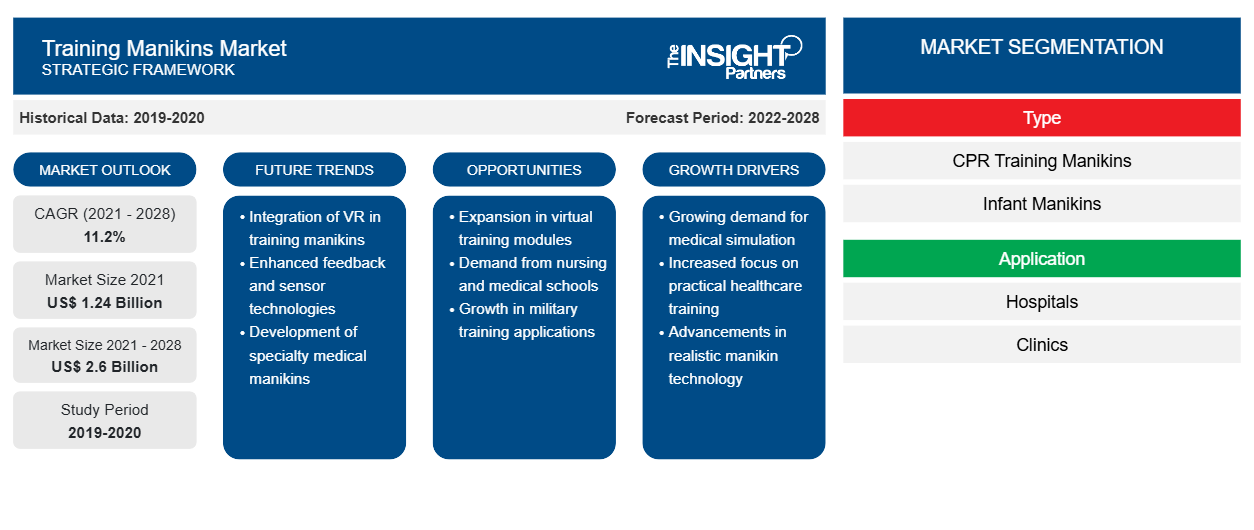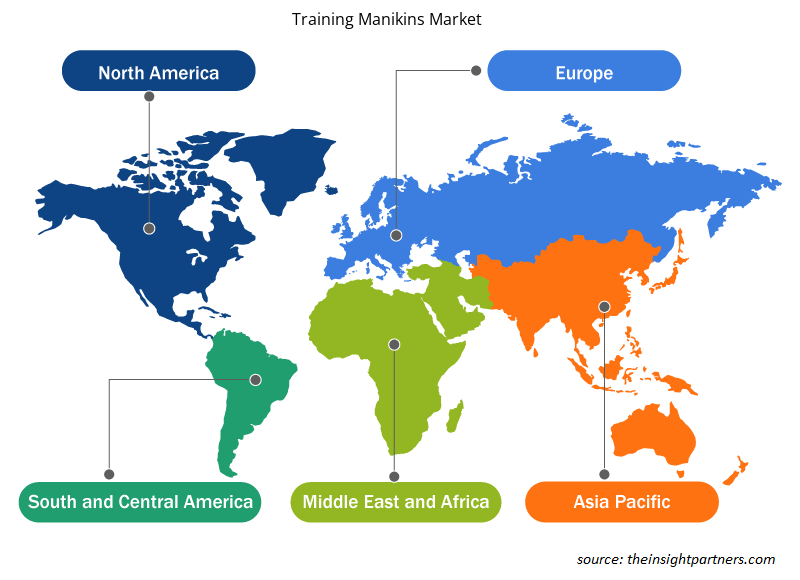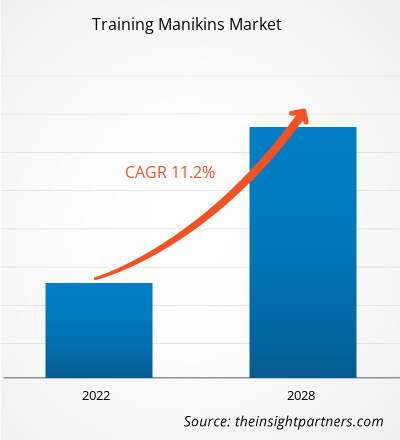Der Markt für Trainingspuppen soll von 3,17 Milliarden US-Dollar im Jahr 2024 auf 9,15 Milliarden US-Dollar im Jahr 2031 anwachsen. Für den Zeitraum 2025–2031 wird eine durchschnittliche jährliche Wachstumsrate (CAGR) von 16,5 % erwartet. Der Einsatz von Robotik, künstlicher Intelligenz (KI) und Augmented Reality entwickelt sich zu einem wichtigen Trend im Markt für Trainingspuppen.
Marktanalyse für Trainingspuppen
Der Markt für Trainingspuppen wird in den kommenden Jahren voraussichtlich aufgrund der steigenden Nachfrage nach Ausbildung im Gesundheitswesen, Notfalltraining und militärischer Vorsorge deutlich wachsen. Da simulationsbasiertes Lernen immer mehr im Vordergrund steht, investieren medizinische Einrichtungen und Trainingszentren in fortschrittliche Trainingspuppen, die realistische Anatomie und physiologische Reaktionen bieten. Der Markt profitiert von technologischen Fortschritten wie KI-Integration und drahtlosen Funktionen, die die Effektivität und Interaktivität von Trainingseinheiten verbessern. Wichtige Akteure konzentrieren sich auf Produktinnovation, strategische Partnerschaften und die Ausweitung ihrer geografischen Reichweite, um sich einen Wettbewerbsvorteil zu verschaffen. Nordamerika dominiert den Markt aufgrund seiner robusten Gesundheitsinfrastruktur und hoher Investitionen in die medizinische Ausbildung. Der asiatisch-pazifische Raum verzeichnet ein rasantes Wachstum, das durch den Ausbau der Gesundheitssysteme sowie das gestiegene Bewusstsein für CPR- und Traumatraining vorangetrieben wird.
Marktübersicht für Trainingspuppen
Das Wachstum des globalen Marktes für Trainingspuppen wird vor allem durch Fortschritte in der Simulationstechnologie vorangetrieben, die den Realismus und die Effektivität der Trainingspuppen verbessert haben. Diese Puppen sind jetzt mit Funktionen wie realistischen anatomischen Strukturen, reagierenden Atemwegen und integrierten Sensoren ausgestattet, was ein umfassendes Training verschiedener medizinischer Verfahren ermöglicht. Die zunehmende Zahl von Herzstillständen außerhalb von Krankenhäusern (OHCA) und die wachsende Bedeutung von CPR-Schulungen und Sensibilisierungsprogrammen tragen zusätzlich zum Marktwachstum bei. Laut den im Jahr 2020 veröffentlichten WHO-Daten erreichte die Zahl der Todesfälle durch koronare Herzkrankheit in Frankreich 63.181. Laut dem Heart Failure Policy Network waren in Frankreich rund 1 Million Menschen von dieser Krankheit betroffen. Darüber hinaus liegt die Prävalenzrate von Herzinsuffizienz bei Menschen ab 70 Jahren bei bis zu 10 %, und jährlich erleiden in Frankreich rund 120.000 Menschen einen Herzinfarkt. Daher steigt die Nachfrage nach Trainingspuppen mit dem zunehmenden Fokus auf Patientensicherheit und der zunehmenden Zahl von OHCA.OHCA ) und die zunehmende Betonung von CPR-Schulungen und Sensibilisierungsprogrammen tragen weiter zum Marktwachstum bei. Laut den im Jahr 2020 veröffentlichten WHO-Daten ist die Zahl der Todesfälle durch OHCA .
Im August 2023 übernahm 3B Scientific, ein führender Hersteller und Anbieter medizinischer Simulationsprodukte und anatomischer Modelle für die Gesundheitsausbildung, Lifecast Body Simulation, um seine Marktposition zu stärken. Im Februar 2023 unterzeichnete Limbs & Things (UK) einen Multimillionen-Pfund-Vertrag mit TruCorp, einem nordirischen Unternehmen für medizinische Simulatoren. Der Vertrag machte Limbs & Things zum exklusiven Lieferanten von TruCorp-Produkten in Großbritannien. Darüber hinaus würde die Nutzung des etablierten Netzwerks von Limbs & Things TruCorps Fähigkeit verbessern, seine gefragten Innovationen in diesen Märkten anzubieten.Lifecast Body Simulation stärkt seine Marktposition. Im Februar 2023 unterzeichnete Limbs & Things (UK) einen Multimillionen-Pfund -Vertrag mit TruCorp , einem nordirischen Unternehmen für medizinische Simulatoren. Der Vertrag machte Limbs & Things zum exklusiven Lieferanten von TruCorp -Produkten in Großbritannien. Darüber hinaus würde die Nutzung des etablierten Netzwerks von Limbs & Things TruCorps Fähigkeit verbessern, seine gefragten Innovationen in diesen Märkten anzubieten.
Passen Sie diesen Bericht Ihren Anforderungen an
Sie erhalten kostenlos Anpassungen an jedem Bericht, einschließlich Teilen dieses Berichts oder einer Analyse auf Länderebene, eines Excel-Datenpakets sowie tolle Angebote und Rabatte für Start-ups und Universitäten
Markt für Trainingspuppen: Strategische Einblicke

-
Informieren Sie sich über die wichtigsten Markttrends in diesem Bericht.Dieses KOSTENLOSE Beispiel umfasst Datenanalysen, von Markttrends bis hin zu Schätzungen und Prognosen.
Markttreiber und -chancen für Trainingspuppen
Technologische Fortschritte fördern das Marktwachstum
Trainingspuppen haben sich technologisch und komplex deutlich weiterentwickelt. Sie sind heute mit hochentwickelten Systemen ausgestattet, die menschliche physiologische Funktionen präzise simulieren. Dank dieser Entwicklung können Trainer Klinikern das Erlernen, Üben und Vervollkommnen ihrer Fähigkeiten bei einfachen und hochkomplexen Verfahren ermöglichen, darunter verschiedene diagnostische und therapeutische Verfahren wie Geburt, Beatmung, Herz-Kreislauf-Behandlung, neurologische Verfahren, pharmakologische Modellierung und Simulation. Diese Puppen sind so konzipiert, dass sie den Teilnehmern Verfahren wie Herz-Lungen-Wiederbelebung, Intubation , Beatmung mit Beutelmaske, Defibrillation und das Legen einer Thoraxdrainage ermöglichen.
CAE Healthcare hat Modelle und Simulatoren für verschiedene Verfahren entwickelt; dazu gehören Produkte von Neugeborenen- bis zu Erwachsenenpuppen. Der Human Patient Simulator ( HPS ) beispielsweise ist eine Ganzkörper-Trainingspuppe zur Unterstützung von Anästhesie und medizinischen Gasen mit patentierter Modellierung von Atmung, Nerven, Herz-Kreislauf-System und Pharmakologie. Er ist der Goldstandard in der hochpräzisen Patientensimulation für das Training von Atemwegen und Intensivmedizin. Der HPS ist mit echten klinischen Monitoren und Beatmungsgeräten verbunden und reagiert automatisch auf die Verabreichung von echten Narkosegasen, Sauerstofftherapie und Arzneimitteln. Lucina , eine weitere wichtige Trainingspuppe, ist ein kabelloser Geburtssimulator mit integrierter Mutter-Kind-Physiologie und austauschbaren statischen Diensten, um die Lernenden in allen Phasen der Geburt und seltenen Notfallszenarien zu trainieren. Die Lucina -Puppe kann realistische, kontrollierbare Geburtsvorgänge von normalen Geburtsszenarien bis hin zu verschiedenen Geburtskomplikationen wie Schulterdystokie und Eklampsie demonstrieren und verfügt über eine hervorragende Artikulation für Wehen- und Entbindungsmanöver.
Laerdal bietet Trainingspuppen und Simulatoren für Erwachsene und Kleinkinder an. Der SimMan 3G ist ein benutzerfreundlicher und tragbarer Patientensimulator für Teamtrainings mit realistischer Anatomie und klinischer Funktionalität. Er bietet simulationsbasiertes Lernen, um die klinischen Fähigkeiten und Entscheidungskompetenzen der Studierenden in realistischen Patientenversorgungsszenarien zu testen. Darüber hinaus sind die Trainingspuppen Nursing Anne, Nursing Kelly, Crash Kelly und Harvey von Laerdal für die klinische Ausbildung in gynäkologischen Bereichen, Geburtshilfe, Wundbeurteilung und -versorgung, Magensondenanlage, kardiopulmonaler Medizin und fortgeschrittenem Atemwegsmanagement konzipiert. Die Produktentwicklung durch technologische Innovationen stärkt daher den Markt für Trainingspuppen.
Steigende Zahl strategischer Initiativen zur Schaffung von Wachstumschancen
Kleine und große Unternehmen im Markt für Trainingspuppen setzen zunehmend auf Strategien zur Umsatzsteigerung. Nachfolgend einige aktuelle Entwicklungen im Markt für Trainingspuppen:
- Im Dezember 2024 brachte Safeguard Medical, ein innovatives Unternehmen im Bereich der Traumaversorgung und medizinischer Simulationsprodukte, die hochmoderne SIMBODIES Pro Manikin auf den Markt. Die SIMBODIES Pro Manikin wurde für die anspruchsvollsten Trainingsumgebungen entwickelt – von Kampfgebieten bis hin zu Hochdruck-Traumazentren – und ist die neueste und fortschrittlichste Ergänzung des SIMBODIES-Portfolios an hyperrealistischen Trainingspuppen. Die in Zusammenarbeit mit dem US-Militär entwickelte SIMBODIES Pro Manikin ist speziell auf die anspruchsvollen Anforderungen professionellen Trainings zugeschnitten und gewährleistet außergewöhnlichen Realismus und Langlebigkeit unter verschiedensten Einsatzbedingungen, egal ob bei extremer Hitze oder eisigen Temperaturen.
- Im Februar 2024 stellte IngMar Medical Aurora vor, eine fortschrittliche medizinische Simulationspuppe, die Kliniker in allen Aspekten der Beatmung schult. Ausgestattet mit der neuen internen simulierten Lunge (ISL) nutzt Aurora die proprietäre ASL 5000-Atemsimulatortechnologie von IngMar und hebt so den Standard der medizinischen Ausbildung. Die Aurora-Puppe hält effektiv therapeutische PEEP-Werte (positiver endexspiratorischer Druck) aufrecht und demonstriert spontane Atmung während der Beatmung. So ist medizinisches Fachpersonal optimal auf eine Vielzahl von Beatmungsszenarien vorbereitet.
- Im August 2023 übernahm 3B Scientific Lifecast Body Simulation. Lifecast hat eine Vielzahl hochpräziser und lebensechter medizinischer Puppen entwickelt, die die Art und Weise, wie medizinische Simulation und Ausbildung vermittelt und verstanden werden, grundlegend verändern.
Daher schafft die aktive Teilnahme von Marktteilnehmern an Produkteinführungen, Erweiterungen, Partnerschaften sowie Fusionen und Übernahmen lukrative Wachstumschancen auf dem Markt für Trainingspuppen.
Marktbericht zu Trainingspuppen – Segmentierungsanalyse
Die wichtigsten Segmente, die die Grundlage der Marktanalyse für Trainingspuppen bilden, sind Typ, Anwendung, Altersgruppe und Endbenutzer.
- Der Markt für Trainingspuppen wird nach Typ in Trainingspuppen für HLW, Krankenpflege, Notfallversorgung, allgemeine Pflege, Basis-Lebenserhaltung und weitere unterteilt. Das Segment der HLW-Trainingspuppen hatte 2024 den größten Marktanteil.
Der Markt für Trainingspuppen ist nach Anwendungsbereichen unterteilt: Intensivmedizin, Geburtshilfe und Gynäkologie, Kardiologie, Pneumologie und weitere. Das Segment Kardiologie dominierte den Markt im Jahr 2024.
- Der Markt für Trainingspuppen ist nach Altersgruppen in Trainingspuppen für Erwachsene, Trainingspuppen für Kinder und Trainingspuppen für Neugeborene unterteilt. Das Segment der Trainingspuppen für Erwachsene hatte im Jahr 2024 den größten Marktanteil.
- Nach Endverbraucher wird der Markt in medizinische Fakultäten und Gemeinschaftsräume, Krankenhäuser, Kliniken und andere Bereiche unterteilt. Das Segment der medizinischen Fakultäten und Gemeinschaftsräume hatte im Jahr 2024 den größten Marktanteil bei Trainingspuppen.
Marktanteilsanalyse für Trainingspuppen nach geografischer Lage
Der geografische Umfang des Marktberichts für Trainingspuppen ist in fünf Regionen unterteilt: Nordamerika, Asien-Pazifik, Europa, Naher Osten und Afrika sowie Süd- und Mittelamerika.
Nordamerika hielt 2024 einen bedeutenden Marktanteil. Technologische Fortschritte führten zur Entwicklung hochpräziser Trainingsmodelle mit Sensoren, KI und Virtual-Reality-Funktionen (VR). Diese erhöhen den Realismus in der medizinischen Ausbildung und verbessern die Lernerfolge. Die zunehmende Bedeutung simulationsbasierten Lernens in der Gesundheitsausbildung hat zudem die Nachfrage nach realistischen Trainingsinstrumenten erhöht, da Institutionen medizinische Fehler reduzieren und die Vorbereitung des medizinischen Fachpersonals verbessern möchten. Regulierungsbehörden und Akkreditierungsorganisationen schreiben zudem die Integration von Simulationstraining in die medizinischen Lehrpläne vor. Unternehmen im Markt für Trainingsmodelle verfolgen zudem Wachstumsstrategien wie die Einführung innovativer Produkte, die das Marktwachstum fördern. Im Juli 2022 brachte das kanadische Unternehmen AHead Simulations ein fortschrittliches Universalmodell namens CARL mit multifunktionalem Kopf auf den Markt. Das Audio-Modell CARL wurde von AHead Simulations in mehrjähriger Forschung, Validierung und mehreren Iterationen entwickelt. Es wurde direkt anhand von Patientenscans hergestellt und verfügt über leicht austauschbare, realistische, weiche Ohren.
Regionale Einblicke in den Markt für Trainingspuppen
Die Analysten von Insight Partners haben die regionalen Trends und Faktoren, die den Markt für Trainingspuppen im Prognosezeitraum beeinflussen, ausführlich erläutert. In diesem Abschnitt werden auch die Marktsegmente und die geografische Lage von Trainingspuppen in Nordamerika, Europa, Asien-Pazifik, dem Nahen Osten und Afrika sowie Süd- und Mittelamerika erläutert.

- Erhalten Sie regionale Daten zum Markt für Trainingspuppen
Umfang des Marktberichts über Trainingspuppen
| Berichtsattribut | Details |
|---|---|
| Marktgröße im Jahr 2024 | 3,17 Milliarden US-Dollar |
| Marktgröße bis 2031 | 9,15 Milliarden US-Dollar |
| Globale CAGR (2025 – 2031) | 16,5 % |
| Historische Daten | 2021-2023 |
| Prognosezeitraum | 2025–2031 |
| Abgedeckte Segmente |
Nach Typ
|
| Abgedeckte Regionen und Länder |
Nordamerika
|
| Marktführer und wichtige Unternehmensprofile |
|
Marktteilnehmerdichte für Trainingspuppen: Auswirkungen auf die Geschäftsdynamik
Der Markt für Trainingspuppen wächst rasant. Die steigende Nachfrage der Endverbraucher ist auf Faktoren wie veränderte Verbraucherpräferenzen, technologische Fortschritte und ein stärkeres Bewusstsein für die Produktvorteile zurückzuführen. Mit der steigenden Nachfrage erweitern Unternehmen ihr Angebot, entwickeln Innovationen, um den Bedürfnissen der Verbraucher gerecht zu werden, und nutzen neue Trends, was das Marktwachstum weiter ankurbelt.
Die Marktteilnehmerdichte beschreibt die Verteilung der in einem bestimmten Markt oder einer bestimmten Branche tätigen Unternehmen. Sie gibt an, wie viele Wettbewerber (Marktteilnehmer) in einem bestimmten Marktraum im Verhältnis zu dessen Größe oder Gesamtmarktwert präsent sind.
Die wichtigsten Unternehmen auf dem Markt für Trainingspuppen sind:
- Ambu A/S,
- Gaumard Scientific Co Inc.,
- Laerdal Medical AS,
- Simulaids Ltd,
- Erler-Zimmer GmbH & Co. KG,
- Nasco Healthcare,
Haftungsausschluss : Die oben aufgeführten Unternehmen sind nicht in einer bestimmten Reihenfolge aufgeführt.

- Überblick über die wichtigsten Akteure auf dem Markt für Trainingspuppen
Marktnachrichten und aktuelle Entwicklungen zum Trainingspuppenmarkt
Der Markt für Trainingspuppen wird durch die Erhebung qualitativer und quantitativer Daten aus Primär- und Sekundärforschung bewertet, die wichtige Unternehmenspublikationen, Verbandsdaten und Datenbanken einbeziehen. Nachfolgend sind einige der Marktentwicklungen aufgeführt:
- Laerdal Medical, ein weltweit führender Anbieter von Simulationslösungen für das Gesundheitswesen, gab seine exklusive weltweite Vertriebspartnerschaft mit SIMCharacters bekannt, einem österreichischen Pionierunternehmen, das sich auf modernste Neonatal-Simulationstechnologie spezialisiert hat. Diese strategische Partnerschaft markiert einen wichtigen Meilenstein in der Weiterentwicklung der Simulation im Gesundheitswesen und unterstreicht das gemeinsame Engagement für eine Revolutionierung der medizinischen Ausbildung. (Quelle: Laerdal Medical, Pressemitteilung, Januar 2024)
- CliniSim, eine Marke der Simulaids Ltd., stellte auf der ASPiH Medical Simulation Conference in Edinburgh „FGM Care Aware“ vor, um medizinisches Fachpersonal bei der Erkennung und Diagnose weiblicher Genitalverstümmelung (FGM) zu unterstützen. Das Produkt wurde in Zusammenarbeit mit einer führenden britischen medizinischen Fakultät entwickelt und hergestellt, um die Ausbildung zu unterstützen und das Bewusstsein für eine Praxis zu schärfen, von der weltweit über 200 Millionen Menschen betroffen sind. (Quelle: Simulaids, Pressemitteilung, November 2024)
Marktbericht zu Trainingspuppen – Umfang und Ergebnisse
Der Bericht „Marktgröße und Prognose für Trainingspuppen (2021–2031)“ bietet eine detaillierte Analyse des Marktes, die die folgenden Bereiche abdeckt:
- Marktgröße und Prognose für Trainingspuppen auf globaler, regionaler und Länderebene für alle wichtigen Marktsegmente, die im Rahmen des Berichts abgedeckt sind
- Markttrends und Marktdynamiken für Trainingspuppen wie Treiber, Einschränkungen und wichtige Chancen
- Detaillierte PEST- und SWOT-Analyse
- Marktanalyse für Trainingspuppen mit Blick auf wichtige Markttrends, globale und regionale Rahmenbedingungen, wichtige Akteure, Vorschriften und aktuelle Marktentwicklungen
- Branchenlandschaft und Wettbewerbsanalyse mit Marktkonzentration, Heatmap-Analyse, prominenten Akteuren und jüngsten Entwicklungen auf dem Markt für Trainingspuppen
- Detaillierte Firmenprofile
- Historische Analyse (2 Jahre), Basisjahr, Prognose (7 Jahre) mit CAGR
- PEST- und SWOT-Analyse
- Marktgröße Wert/Volumen – Global, Regional, Land
- Branchen- und Wettbewerbslandschaft
- Excel-Datensatz
Aktuelle Berichte
Erfahrungsberichte
Grund zum Kauf
- Fundierte Entscheidungsfindung
- Marktdynamik verstehen
- Wettbewerbsanalyse
- Kundeneinblicke
- Marktprognosen
- Risikominimierung
- Strategische Planung
- Investitionsbegründung
- Identifizierung neuer Märkte
- Verbesserung von Marketingstrategien
- Steigerung der Betriebseffizienz
- Anpassung an regulatorische Trends






















 Kostenlose Probe anfordern für - Markt für Trainingspuppen
Kostenlose Probe anfordern für - Markt für Trainingspuppen